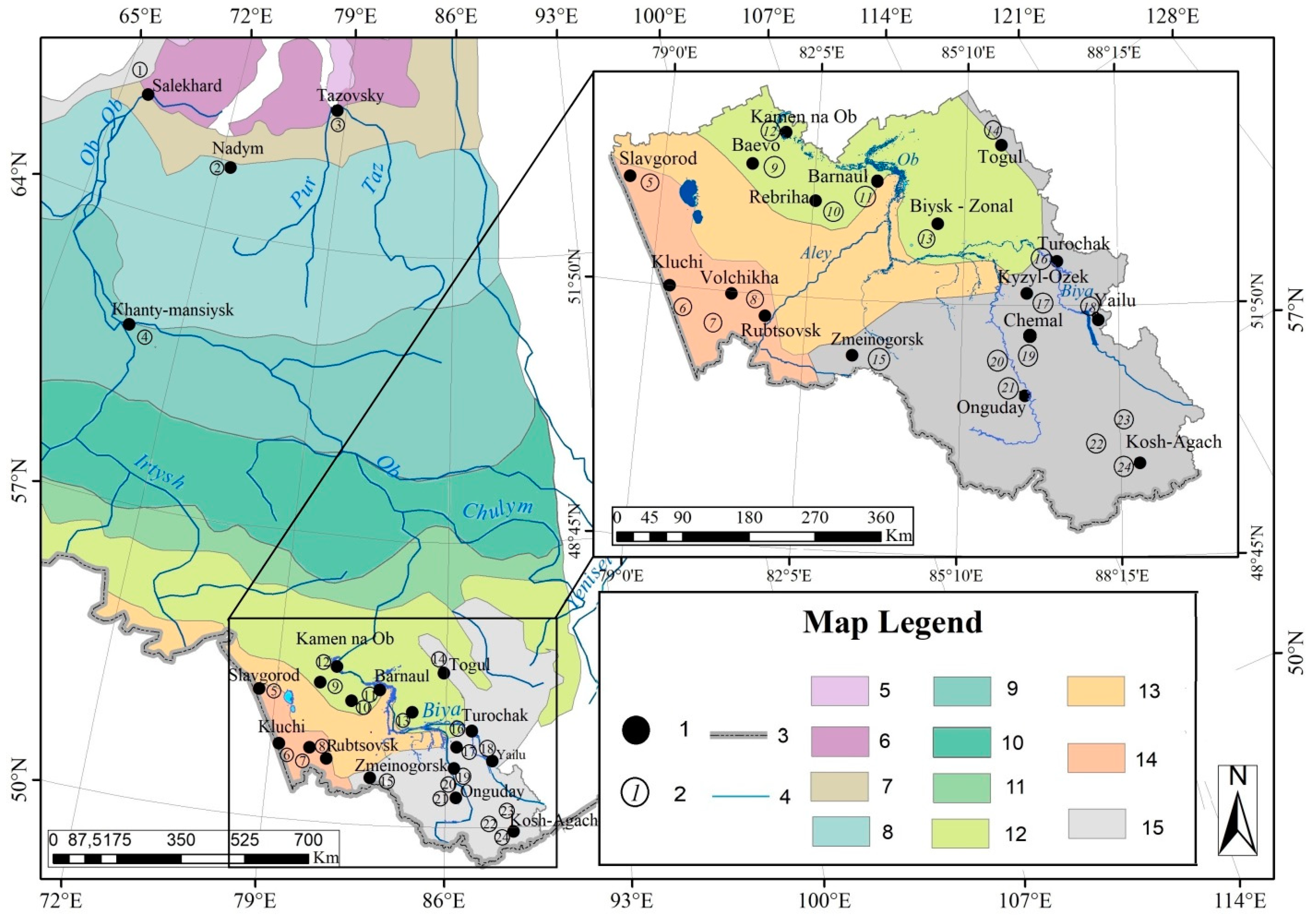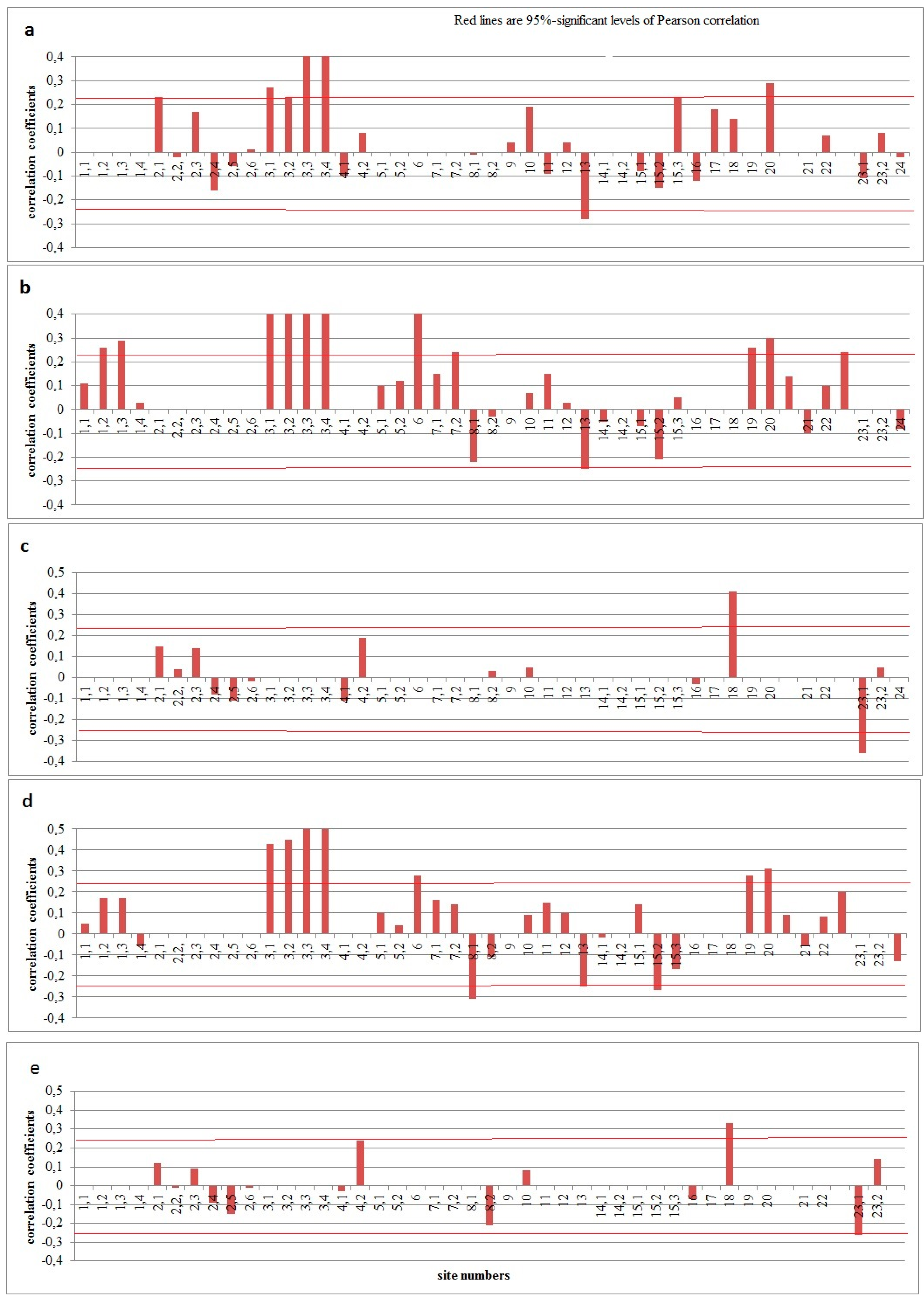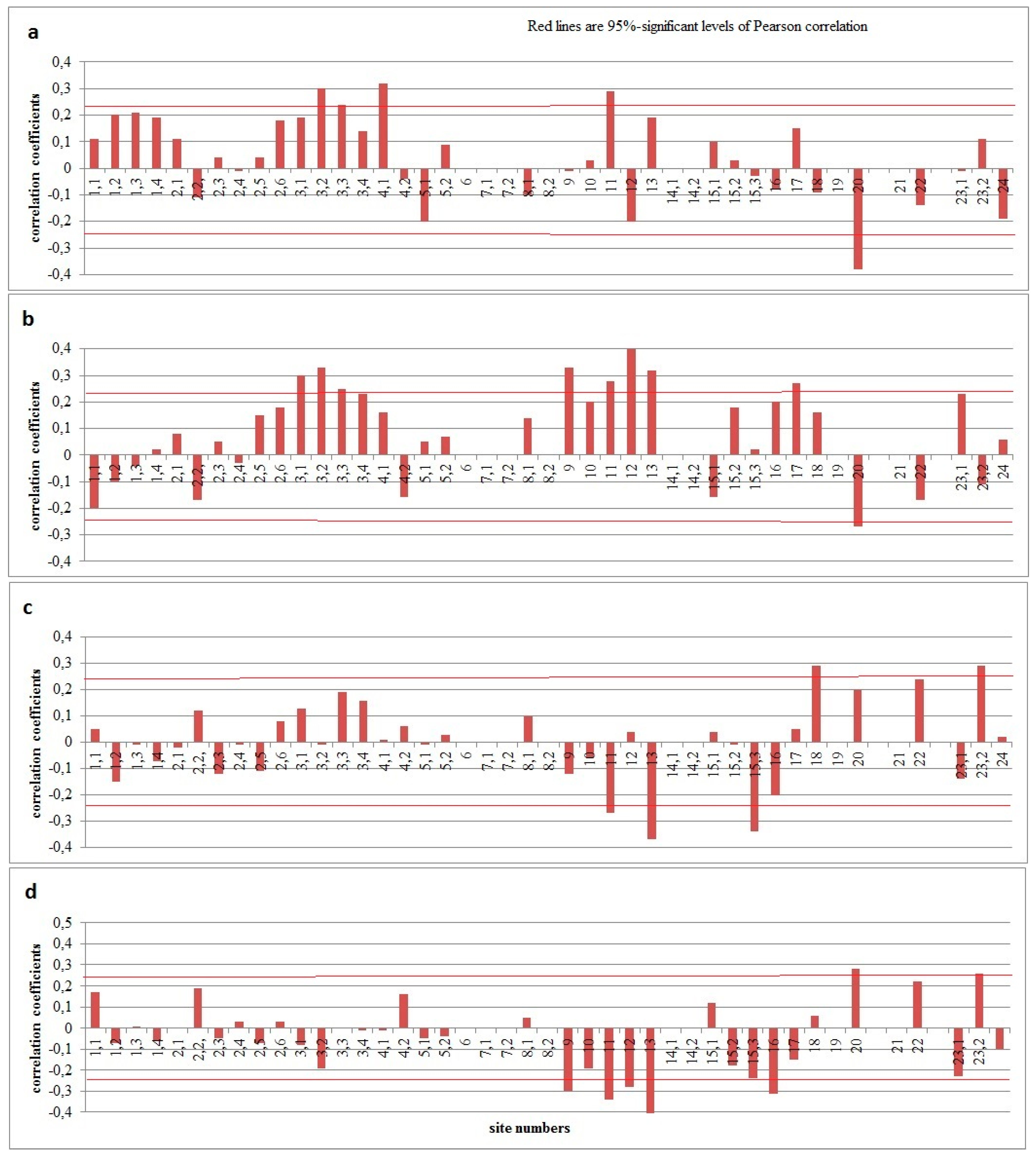Submitted:
20 July 2023
Posted:
21 July 2023
You are already at the latest version
Abstract
Keywords:
1. Introduction
2. Materials and Methods
3. Results and Discussion
4. Conclusions
Author Contributions
Funding
Data Availability Statement
Acknowledgments
Conflicts of Interest
References
- Bykov, N.I.; Popov, E.S. Observations on the Dynamics of Snow Cover in the Protected Areas of the Altai-Sayan Ecoregion (Methodological Guide); Typography “Gorod”: Krasnoyarsk, Russia, 2011; 64p. [Google Scholar]
- Bykov, N.I. Dendroindication of the long-term dynamics of the elements of the nival-glacial complex. In Problems of Reconstruction of the Climate and Natural Environment of the Holocene and Pleistocene of Siberia; Publishing House of the Institute of Archeology and Ethnography SB RAS: Novosibirsk, Russia, 1998; pp. 51–55. [Google Scholar]
- Bykov, N.I.; Rygalova, N.V.; Shigimaga, A.A. Snow cover as a factor of radial growth of woody plants in different habitats of Altai. Acta Biol. Sib. 2022, 8, 557–569. [Google Scholar] [CrossRef]
- Bykov, N.I.; Shigimaga, A.A.; Rygalova, N.V. Snow Cover as a Factor of Growth of Annual Tree Rings under Contrasting Environmental Conditions of the West Siberian Plain. Ice Snow 2023, 63, 243–256. [Google Scholar]
- Gedalof, Z.; Smith, D.J. Dendroclimatic response of mountain hemlock (Tsuga mertensiana) in Pacific North America. Can. J. For. Res. 2001, 31, 322–332. [Google Scholar] [CrossRef]
- Falarz, M. Tree-Ring Widths and Snow Cover Depth in High Tauern. IOP Conf. Ser. Earth Environ. 2017, 95, 062005. [Google Scholar] [CrossRef]
- Sanmiguel-Vallelado, A.; Camarero, J.J.; Gazol, A.; Morán-Tejeda, E.; López-Moreno, J.I. Detecting snow-related signals in radial growth of Pinus uncinata mountain forests. Dendrochronologia 2019, 57, 125622. [Google Scholar] [CrossRef]
- Nikolaev, A.N.; Skachkov, Y.B. Influence of snow cover dynamics on the growth and development of forests in Central Yakutia. Cryosphere Earth 2011, 3, 71–80. [Google Scholar]
- Owczarek, P.; Opała, M. Dendrochronology and extreme pointer years in the tree-ring record (AD 1951–2011) of polar willow from southwestern Spitsbergen (Svalbard, Norway). Geochronometria 2016, 43, 84–95. [Google Scholar] [CrossRef]
- Schmidt, N.M.; Baittinger, C.; Kollmann, J.; Forchhammer, M.C. Consistent dendrochronological response of the dioecious Salix arctica to variation in local snow precipitation across gender and vegetation types. Arct. Antarct. Alp. Res. 2010, 42, 471–475. [Google Scholar] [CrossRef]
- Vaganov, E.A.; Kirdyanov, A.V.; Schweingruber, F.H.; Silkin, P.P. Influence of snowfall and melt timing on tree growth in subarctic Eurasia. Nature 1999, 400, 149–151. [Google Scholar] [CrossRef]
- Watson, E.; Luckman, B.H. An investigation of the snowpack signal in moisture-sensitive trees from the Southern Canadian Cordillera. Dendrochronologia 2016, 38, 118–130. [Google Scholar] [CrossRef]
- Woodhouse, C.A. A 431-yr reconstruction of western Colorado snowpack from tree rings. J. Clim. 2003, 16, 1551–1561. [Google Scholar] [CrossRef]
- Qin, L.; Yuan, Y.; Zhang, R.; Wei, W.; Yu, S.; Fan, Z.; Chen, F.; Zhang, T.; Shang, H. Tree-ring response to snow cover and reconstruction of century annual maximum snow depth for Northern Tianshan mountains, China. Geochronometria 2016, 43, 9–17. [Google Scholar] [CrossRef]
- Kirdyanov, A.; Hughes, M.; Vaganov, E.; Schweingruber, F.; Silkin, P. The importance of early summer temperature and date of snow melt for tree growth in the Siberian Subarctic. Trees 2003, 17, 61–69. [Google Scholar] [CrossRef]
- Hart, S.J.; Smith, D.J.; Clague, J.J. A multi-species dendroclimatic reconstruction of Chilco River streamflow, British Columbia, Canada. Hydrol. Process. 2010, 24, 2752–2761. [Google Scholar] [CrossRef]
- Vaganov, E.A.; Shiyatov, S.G.; Mazepa, V.S. Dendroclimatic Research in the Ural-Siberian Subarctic; Nauka: Novosibirsk, Russia, 1996; 246p. [Google Scholar]
- Dolgova, E.A.; Solomina, O.N.; Matskovsky, V.V.; Cherenkova, E.A.; Semenyak, N.S. Climate signal strength in tree-ring width of spruce growing in the Solovetsky Islands (Russia). Dendrochronologia 2022, 76, 126012. [Google Scholar] [CrossRef]
- Rygalova, N.V.; Bykov, N.I.; Shigimaga, A.A. Radial Growth of Woody Plants in Extrazonal and Anthropogenic Landscapes of the Dry Steppe of the Western Siberian Plain. Arid. Ecosyst. 2022, 12, 61–67. [Google Scholar] [CrossRef]
- Shiyatov, S.G.; Vaganov, E.A.; Kirdyanov, A.V.; Kruglov, V.B.; Mazepa, V.S.; Naurzbaev, M.M.; Khantemirov, R.M. Methods of Dendrochronology; Publishing House of Krasnoyarsk State University: Krasnoyarsk, Russia, 2000; 80p. [Google Scholar]
- Bykov, N.I.; Shigimaga, A.A.; Ilyasov, R.M. Peculiarities of radial growth of woody plants in the forest-tundra of the Yamalo-Nenets Autonomous Okrug. Sci. Bull. Yamalo-Nenets Auton. Okrug 2022, 2, 98–112. [Google Scholar] [CrossRef]
- Snow Course Survey. Available online: http://aisori-m.meteo.ru/waisori/index0.xhtml (accessed on 20 May 2022).
- Snow Cover Characteristics (Daily Data). Available online: http://aisori-m.meteo.ru/waisori/index0.xhtml (accessed on 20 May 2022).
- Nikolaev, A.N.; Skachkov, Y.B. Influence of snow cover and temperature regime of permafrost soils on the radial growth of trees in Central Yakutia. J. Sib. Fed. Univ. Ser. Biol. 2012, 1, 43–51. [Google Scholar]
- Demina, A.V.; Belokopytova, L.V.; Andreev, S.G.; Kostyakova, T.V.; Babushkina, E.A. Dynamics of radial growth of Scots pine (Pinus sylvestris L.) as an indicator of the hydrothermal regime of the forest-steppe of Western Transbaikalia. Sib. Ecol. J. 2017, 5, 553–566. [Google Scholar]



| Lot number | Site and position | species | weather station | Comparison period with weather data |
|---|---|---|---|---|
| forest tundra | ||||
| 3 | 3.1. Plakor | Larix sibirica L. | Tazovsk | 1966–2020 |
| 3.2. lower slope | Larix sibirica L. | Tazovsk | 1966–2020 | |
| 3.3. Plakor | Larix sibirica L. | Tazovsk | 1966–2020 | |
| 3.4. river terrace | Larix sibirica L. | Tazovsk | 1966–2020 | |
| northern taiga | ||||
| 2 | 2.1. lower slope | Larix sibirica L. | Nadym | 1966–2020 |
| 2.2. lower slope | Picea obovata L. | Nadym | 1966–2020 | |
| 2.3. top of the slope | Larix sibirica L. | Nadym | 1966–2020 | |
| 2.4. top of the slope | Picea obovata L. | Nadym | 1966–2020 | |
| 2.5. top of the slope | Pinus sibirica | Nadym | 1966–2020 | |
| 2.6. Terrace of the Nadym River | Pinus sylvestris L. | Nadym | 1966– 2020 | |
| Middle taiga | ||||
| 4 | 4.1. Terrace of the Ob River | Pinus sylvestris L. | Khanty-Mansiysk | 1966–2020 |
| 4.2. Terrace of the Ob River | Pinus sibirica Du Tour | Khanty-Mansiysk | 1966–2020 | |
| dry steppe | ||||
| 5 | 5.1. forest belt | Pinus sylvestris L. | Slavgorod | 1975–2018 |
| 5.2. forest belt | Betula pendula Roth | Slavgorod | 1978–2018 | |
| 6 | pine forest, mane top, dry habitat | Pinus sylvestris L. | Kluchi | 1966–2007 |
| 7 | 7.1. Ancient runoff hollow, pine forest, mane top, dry habitat | Pinus sylvestris L. | Kluchi | 1966–2007 |
| 7.2. forest belt | Betula pendula Roth | Kluchi | 1966–2018 | |
| 8 | 8.1. Ancient runoff hollow, pine forest, wet habitat | Pinus sylvestris L. | Rubtsovsk | 1966–2005 |
| 8.2. Ancient runoff hollow, pine forest, wet habitat | Pinus sylvestris L. | Volchicha | 1966–2002 | |
| southern forest-steppe | ||||
| 9 | Ancient runoff hollow, pine forest | Pinus sylvestris L. | Kamen’ na Ob | 1966–2005 |
| 10 | Ancient runoff hollow, pine forest | Pinus sylvestris L. | Rebriha | 1966–2007 |
| 11 | Ancient runoff hollow, pine forest | Pinus sylvestris L. | Barnaul | 1966–2007 |
| 12. | Ancient runoff hollow, pine forest | Pinus sylvestris L. | Kamen’na Ob | 1966–2007 |
| northern forest-steppe | ||||
| 13 | pine forest | Pinus sylvestris L. | Biysk-Zonal | 1966–2020 |
| Lot number | Site and position, height above sea level, in m | species | weather station | Comparison period with weather data |
|---|---|---|---|---|
| Upper part of the forest belt | ||||
| 1 | 1.1. Slope southeast exposure, 250 m | Larix sibirica L. | Salekhard | 1966–2020 |
| 1.2. Slope of southwestern exposure, 250 m | Larix sibirica L. | Salekhard | 1966–2020 | |
| 1.3. Slope with northwestern exposure, 250 m | Larix sibirica L. | Salekhard | 1966–2020 | |
| 1.4. Slope of southwestern exposure, 220 m | Duschekia fruticosa | Salekhard | 1966–2020 | |
| 15 | 15.1. Tigiretsky ridge, 1290 m | Larix sibirica L. | Zmeinogorsk | 1966–2020 |
| 15.2. Tigiretsky ridge, 1430 m | Abies sibirica L. | Zmeinogorsk | 1966–2020 | |
| 20 | Seminsky ridge, 1890 m | Pinus sibirica Du Tour | Biysk-Zonal | 1966–2020 |
| Onguday | 1966–2020 | |||
| 22. | Severo-Chuysky ridge, 2280 m | Larix sibirica L. | Biysk-Zonal | 1966–2020 |
| Onguday | 1966–2020 | |||
| 23 | 23.1. Kurai Range, 2120 m | Larix sibirica L. | Yailu | 1966–2020 |
| Lower part of the forest belt | ||||
| 14 | 14.1. Salair Ridge, upland, 310 m | Abies sibirica L. | Togul | 1966–2020 |
| 14.2. Salair Ridge, upland, 310 m | Tilia sibirica Bayer | Togul | 1966–2020 | |
| 15 | 15.3. Tigiretsky ridge, 590 m | Abies sibirica L. | Zmeinogorsk | 1966–2020 |
| 16 | Terrace of the Lebed’ River, 330 m | Pinus sylvestris L. | Turochak | 1966–2020 |
| 17 | Maima river valley, 370 m | Pinus sylvestris L. | Kyzyl-Ozek | 1966–2020 |
| 18 | Shore of Teletskoye Lake, 450 m | Larix sibirica L | Yailu | 1966–2020 |
| 19 | Valley of the Katun River, 490 m | Pinus sylvestris L. | Chemal | 1966–2020 |
| 21 | Ursul basin, 1035 m | Larix sibirica L. | Onguday | 1966–2020 |
| 23 | 23.2 Kurai Range, 1330 m | Larix sibirica L. | Yailu | 1966–2020 |
| 24 | Chui hollow, 1760 m | Larix sibirica L | Kosh-Agach | 1966–2020 |
| weather station | height above sea level, m | Hmax | Wmax | Du | Dr | P |
|---|---|---|---|---|---|---|
| Tazovsky | 26 | 35 | 93 | 10.X | 30.V | 231 |
| Salekhard | 15 | 54 | 143 | 13.X | 20.V | 218 |
| Nadym | 14 | 80 | 191 | 12.X | 15.V | 213 |
| Khanty-Mansiysk | 46 | 62 | 148 | 25.X | 23.IV | 180 |
| Slavgorod | 125 | 22 | 59 | 12.XI | 01.IV | 139 |
| Kluchi | 142 | 21 | 52 | |||
| Volchicha | 207 | 33 | 93 | |||
| Rubtsovsk | 216 | 21 | 49 | 09.XI | 06.IV | 141 |
| Kamen na Ob | 127 | 29 | 71 | 06.XI | 02.IV | 146 |
| Baevo | 121 | 24 | 66 | |||
| Rebriha | 218 | 35 | 97 | 06.XI | 08.IV | 153 |
| Barnaul | 183 | 34 | 85 | 03.XI | 08.IV | 155 |
| Biysk-Zonal | 210 | 50 | 130 | 10.XI | 10.IV | 140 |
| Togul | 310 | 59 | 152 | |||
| Zmeinogorsk | 354 | 44 | 116 | 09.XI | 09.IV | 151 |
| Turochak | 330 | 69 | 169 | 02.XI | 16.IV | 166 |
| Yailu | 450 | 53 | 122 | 12.XI | 01.IV | 139 |
| Kyzyl-Ozek | 370 | 56 | 05.XI | 07.IV | 152 | |
| Chemal | 490 | 13 | 23 | |||
| Onguday | 1039 | 19 | 34 | |||
| Kosh-Agach | 1760 | 8 | 21 | 17.XI | 14.III | 121 |
| Site | October | November | December | January | February | March | April | May |
|---|---|---|---|---|---|---|---|---|
| 1.1 | 0.25/0.30 | 0.25/0.24 | 0.34/0.36 | 0.22/0.25 | 0.34/0.28 | 0.33/0.33 | 0.16/0.16 | 0.04/0.10 |
| 1.2 | 0.30/0.31 | 0.32/0.23 | 0.39/0.37 | 0.28/0.29 | 0.42/0.34 | 0.41/0.39 | 0.21/0.19 | 0.00/0.03 |
| 1.3 | 0.31/0.28 | 0.25/0.18 | 0.35/0.29 | 0.27/0.24 | 0.41/0.30 | 0.34/0.29 | 0.19/0.14 | 0.06/0.07 |
| 1.4 | 0.40/0.40 | 0.24/0.13 | 0.33/0.28 | 0.32/0.28 | 0.31/0.22 | 0.27/0.25 | 0.17/0.06 | 0.06/0.02 |
| 2.1 | 0.19/−0.32 | 0.06/0.00 | 0.11/0.02 | −0.01/−0.06 | 0.04/−0.05 | −0.06/−0.14 | 0.00/−0.09 | |
| 2.2. | 0.16/−0.20 | −0.07/−0.06 | −0.07/−0.01 | −0.23/−0.22 | −0.27/−0.28 | −0.23/−0.32 | −0.10/−0.21 | |
| 2.3 | 0.20/−0.14 | 0.06/−0.01 | 0.14/0.05 | 0.06/0.02 | 0.13/0.06 | 0.00/−0.11 | −0.01/−0.04 | |
| 2.4 | 0.31/−0.08 | 0.08/0.08 | 0.01/0.07 | −0.13/−0.02 | −0.15/−0.08 | −0.26/−0.28 | −0.18/−0.20 | |
| 2.5 | −0.04/−0.33 | −0.08/−0.13 | 0.04/−0.01 | −0.07/−0.13 | −0.05/−0.17 | −0.04/−0.15 | 0.15/0.09 | |
| 2.6 | −0.16/−0.01 | −0.16/−0.19 | −0.07/−0.11 | −0.10/−014 | −0.10/−0.19 | −0.09/−0.07 | −0.02/−0.12 | |
| 3.1 | 0.09/0.14 | 0.33/0.28 | 0.42/0.42 | 0.43/0.37 | 0.37/0.42 | 0.42/0.42 | 0.48/0.37 | 0.17/0.12 |
| 3.2 | 0.06/0.16 | 0.32/0.37 | 0.43/0.44 | 0.45/0.39 | 0.40/0.42 | 0.43/0.43 | 0.47/0.39 | 0.19/0.22 |
| 3.3 | 0.12/0.09 | 0.50/0.25 | 0.59/0.47 | 0.61/0.45 | 0.56/0.52 | 0.53/0.50 | 0.54/0.41 | 0.15/0.11 |
| 3.4 | 0.22/0.19 | 0.51/0.35 | 0.57/0.47 | 0.60/0.47 | 0.56/0.57 | 0.55/0.57 | 0.61/0.48 | 0.30/0.21 |
| 4.1 | −0.06/0.12 | −0.30/−0.39 | −0.14/−0.38 | −0.06/−0.21 | 0.02/−0.22 | −0.17/−0.29 | −0.17/−0.15 | 0.00/0.15 |
| 4.2 | 0.02/0.03 | −0.15/−0.37 | 0.08/−0.21 | 0.29/−0.14 | 0.24/−0.07 | 0.05/−0.21 | 0.14/−0.06 | 0.16/0.39 |
| 5.1. | 0.28/0.18 | 0.13/0.08 | 0.31/0.26 | 0.20/0.17 | 0.13/0.13 | 0.06/0.08 | 0.55/0.17 | |
| 5.2 | 0.27/0.74 | 0.09/0.03 | 0.29/0.21 | 0.22/0.17 | 0.16/0.10 | 0.05/0.02 | 0.32/−0.04 | |
| 6 | 0.05/−0.23 | 0.03/0.09 | 0.15/0.36 | 0.13/0.16 | 0.13/0.08 | 0.12/0.15 | 0.29/0.09 | |
| 7.1 | −0.13/−0.56 | 0.21/0.27 | 0.16/0.39 | 0.09/0.10 | 0.09/0.06 | 0.12/0.12 | 0.32/0.24 | |
| 7.2 | 0.27/0.06 | 0.38/0.33 | 0.36/0.50 | 0.34/0.46 | 0.27/0.26 | 0.15/0.29 | −0.18/−0.28 | |
| 8.1 | −0.24 | −0.37/−0.47 | −0.17/−0.26 | −0.39/−0.42 | −0.31/−0.39 | −0.14/−0.12 | −0.32/−0.51 | |
| 8.2 | −0.37/−0.50 | −0.82/−0.16 | −0.76/−0.15 | −0.40/−0.13 | −0.65/−0.10 | 0.05/−0.11 | −0.12/−0.12 | |
| 9 | −0.17/−0.69 | −0.01/−0.13 | 0.02/0.05 | −0.06/−0.09 | −0.04/−0.10 | −0.15/−0.17 | −0.25/−0.24 | |
| 10 | −0.17/−0.31 | 0.00/−0.27 | 0.08/0.08 | −0.07/−0.14 | 0.05/0.08 | −0.01/0.02 | −0.12/−0.10 | |
| 11 | −0.36/−0.49 | −0.03/−0.31 | 0.08/−0.03 | −0.02/−0.16 | 0.09/0.06 | 0.10/−0.12 | −0.17/−0.30 | |
| 12 | −0.03/−0.66 | −0.10/−0.24 | −0.26/−0.29 | −0.26/−0.24 | 0.04/0.07 | 0.06/0.09 | −0.12/−0.05 | |
| 13 | −0.06/0.03 | −0.03/−0.04 | −0.39/−0.34 | −0.29/−0.31 | −0.34/−0.28 | −0.34/−0.31 | −0.21/0.03 | |
| 14.1 | −0.04/−0.04 | −0.19/−0.31 | −0.06/−0.17 | −0.07/−0.04 | −0.05/−0.03 | −0.15/−0.10 | −0.22/−0.21 | |
| 14.2 | −0.30/−0.19 | −0.20/−0.16 | −0.01/−0.08 | 0.16/0.14 | 0.05/0.03 | 0.04/0.04 | 0.15/0.18 | |
| 15.1 | −0.21/0.14 | 0.04/−0.08 | 0.13/0.10 | 0.05/0.15 | 0.11/0.14 | 0.09/0.14 | 0.13/0.17 | |
| 15.2 | −0.31/0.12 | −0.02/−0.11 | 0.10/0.09 | 0.00/0.12 | 0.05/0.11 | 0.04/0.12 | 0.11/0.19 | |
| 15.3 | 0.31/0.03 | 0.06/−0.05 | 0.02/−0.12 | 0.10/−0.12 | −0.04/−0.13 | −0.08/−0.19 | −0.11/−0.26 | |
| 16 | −0.15/0.11 | −0.03/0.04 | −0.24/−0.15 | −0.10/−0.04 | −0.05/−0.01 | −0.21/−0.20 | −0.10/−0.07 | |
| 17 | 0.00/ | −0.01/ | −0.05/ | 0.10/ | 0.07/ | 0.19/ | −0.26/ | |
| 18 | −0.17/−0.22 | 0.18/0.07 | 0.08/0.13 | 0.18/0.07 | 0.33/0.20 | 0.38/0.29 | 0.38/0.55 | |
| 19 | 0.07/−0.41 | 0.01/0.08 | 0.16/0.12 | 0.21/0.22 | 0.47/0.41 | 0.34/0.41 | −0.12/−0.41 | |
| 20 | 0.35/0.21 | 0.17/0.01 | 0.22/0.20 | 0.19/0.25 | 0.24/0.25 | 0.31/0.33 | 0.37/0.34 | |
| −0.32/−0.74 | 0.10/0.21 | 0.17/0.12 | 0.09/0.14 | 0.14/0.10 | 0.23/0.13 | −0.07/0.83 | ||
| 21 | 0.29/−0.29 | −0.08/−0.13 | −0.04/−0.10 | −0.09/−0.13 | −0.09/−0.08 | 0.05/−0.03 | 0.20/0.49 | |
| 22 | −0.03/0.18 | 0.07/0.17 | −0.09/0.12 | −0.08/0.23 | 0.01/0.25 | 0.08/0.25 | 0.06 | |
| 0.38/0.45 | 0.04/0.02 | 0.17/0.09 | 0.03/−0.01 | 0.05/0.09 | 0.12/0.11 | 0.36/0.34 | ||
| 23.1 | −0.61/0.10 | −0.23/−0.32 | −0.22/−0.26 | −0.22/−0.20 | −0.25/−0.12 | −0.36/−0.22 | −0.29/−049 | |
| 23.2 | 0.68/−0.08 | 0.00/0.02 | 0.18/0.21 | 0.10/0.11 | 0.02/0.02 | 0.09/0.15 | 0.44/0.44 | |
| 24 | −0.19/−0.15 | 0.04/−0.02 | 0.06/0.05 | −0.01/0.00 | −0.08/−0.06 | 0.00/−0.09 |
Disclaimer/Publisher’s Note: The statements, opinions and data contained in all publications are solely those of the individual author(s) and contributor(s) and not of MDPI and/or the editor(s). MDPI and/or the editor(s) disclaim responsibility for any injury to people or property resulting from any ideas, methods, instructions or products referred to in the content. |
© 2023 by the authors. Licensee MDPI, Basel, Switzerland. This article is an open access article distributed under the terms and conditions of the Creative Commons Attribution (CC BY) license (http://creativecommons.org/licenses/by/4.0/).





